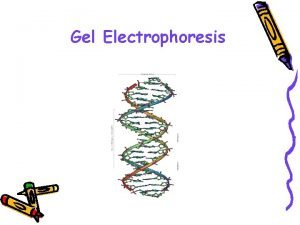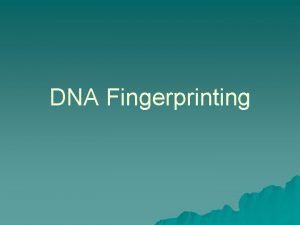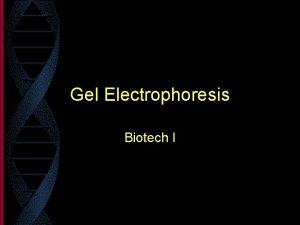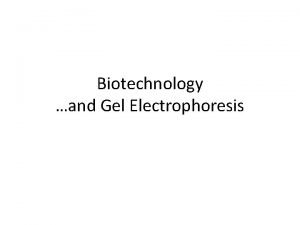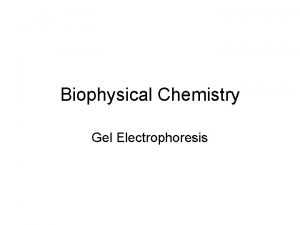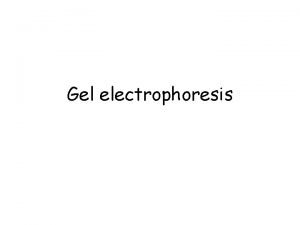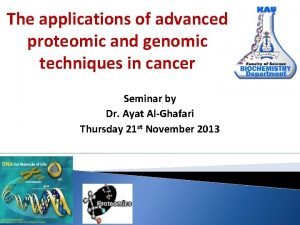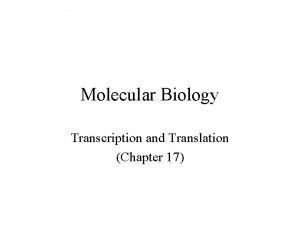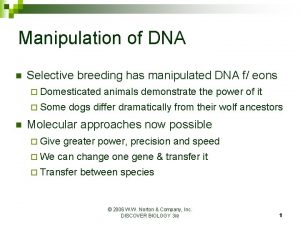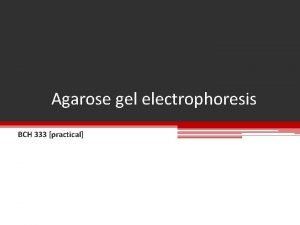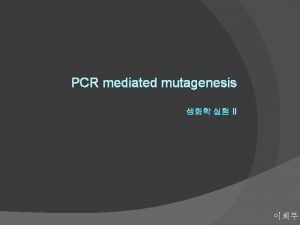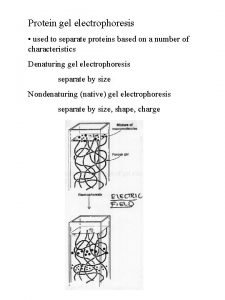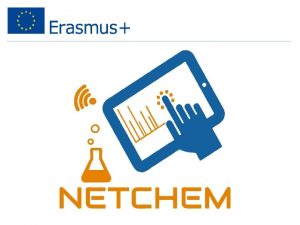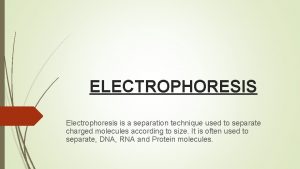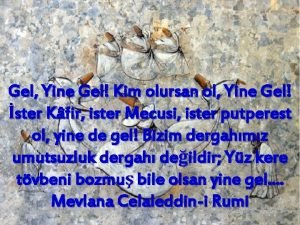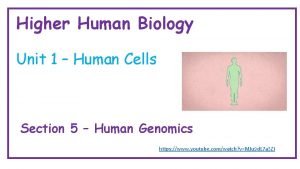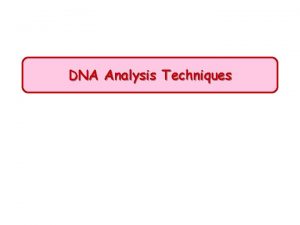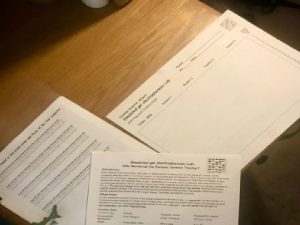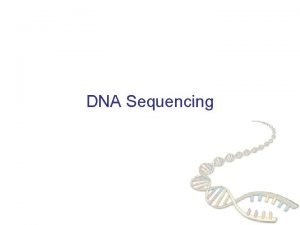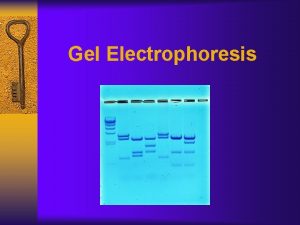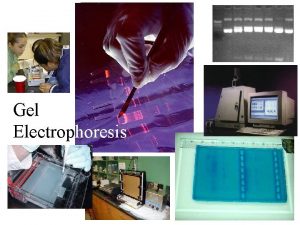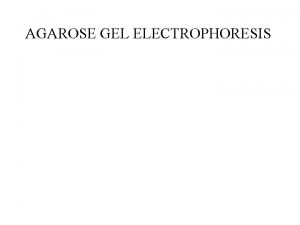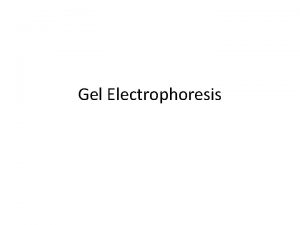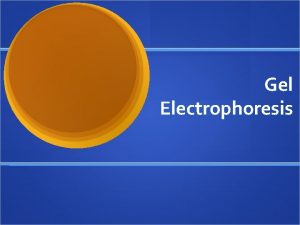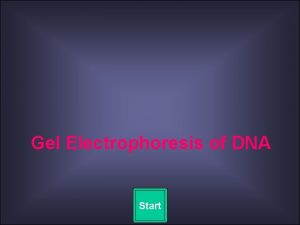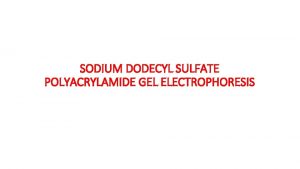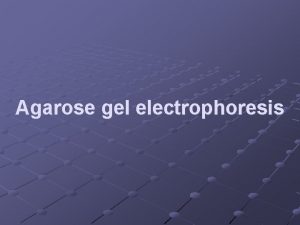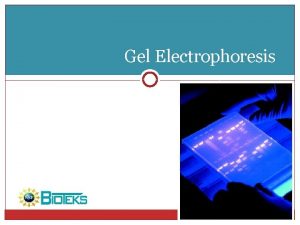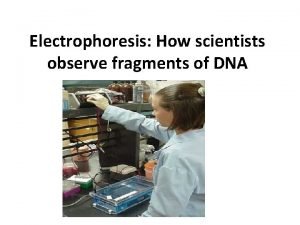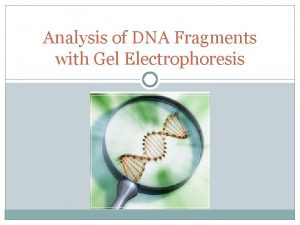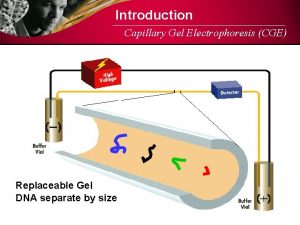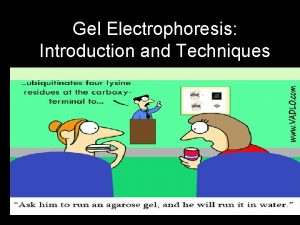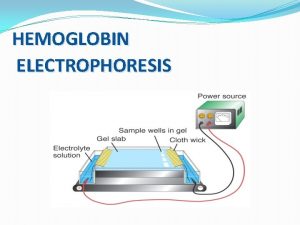Gel electrophoresis Definition Separation of DNA fragments according






























- Slides: 30

Gel electrophoresis

Definition • Separation of DNA fragments according to size, based on movement through a gel medium when an electric field is applied.

DNA negatively charged

DNA cut up using restriction endonucleases


Make up the gel which the DNA will be put into




Dye added to the DNA

Buffer solution added to the tank

DNA samples loaded into wells

Electrical current applied to the chamber

DNA is stained using ethidium bromide

How to read a Gel! • Gels are read in base pairs. • Gels are read with guides called ladders. • …. the size of the DNA band will be predetermined. . the actual size of your gel bands will determine whether this particular DNA is present lls e W

Stages of DNA Profiling • Stage 1: Cells are broken down to release DNA If only a small amount of DNA is available it can be amplified using the polymerase chain reaction (PCR)

Stages of DNA Profiling • Step 2: The DNA is cut into fragments using restriction enzymes. Each restriction enzyme cuts DNA at a specific base sequence.

Stages of DNA Profiling Stage 3: • Fragments are separated on the basis of size using a process called gel electrophoresis. • DNA fragments are injected into wells and an electric current is applied along the gel.

Stages of DNA Profiling DNA is negatively charged so it is attracted to the positive end of the gel. The shorter DNA fragments move faster than the longer fragments. DNA is separated on basis of size.

Stages of DNA Profiling • A radioactive material is added which combines with the DNA fragments to produce a fluorescent image. • A photographic copy of the DNA bands is obtained.

Stages of DNA Profiling Stage 4: • The pattern of fragment distribution is then analysed.

Uses of DNA Profiling • DNA profiling is used to solve crimes and medical problems

Crime • Forensic science is the use of scientific knowledge in legal situations. • The DNA profile of each individual is highly specific. • The chances of two people having exactly the same DNA profile is 30, 000 million to 1 (except for identical twins).

Biological materials used for DNA profiling • • Blood Hair Saliva Body tissue cells

DNA Profiling can solve crimes • The pattern of the DNA profile is then compared with those of the victim and the suspect. • If the profile matches the suspect it provides strong evidence that the suspect was present at the crime scene (it does not prove they committed the crime). • If the profile doesn’t match the suspect then that suspect may be eliminated from the enquiry.

Example • A violent murder occurred. • The forensics team retrieved a blood sample from the crime scene. • They prepared DNA profiles of the blood sample, the victim and a suspect as follows:

Was the suspect at the crime scene? Suspects Profile Blood sample from crime scene Victims profile

Solving Medical Problems DNA profiles can be used to determine whether a particular person is the parent of a child. A childs paternity (father) and maternity(mother) can be determined. This information can be used in • Paternity suits • Inheritance cases • Immigration cases

Example: A Paternity Test • By comparing the DNA profile of a mother and her child it is possible to identify DNA fragments in the child which are absent from the mother and must therefore have been inherited from the biological father.

Is this man the father of the child? Mother Child Man
 Why dna is negatively charged
Why dna is negatively charged Electrolysis gel
Electrolysis gel Gel electrophoresis separates dna by
Gel electrophoresis separates dna by Vertical gel electrophoresis
Vertical gel electrophoresis Gel electrophoresis definition
Gel electrophoresis definition Gel electrophoresis definition
Gel electrophoresis definition Gel electrophoresis cathode anode
Gel electrophoresis cathode anode Process of gel electrophoresis
Process of gel electrophoresis Translate image
Translate image Restriction enzymes gel electrophoresis
Restriction enzymes gel electrophoresis Apparatus of electrophoresis
Apparatus of electrophoresis Gel electrophoresis advantages
Gel electrophoresis advantages Agarose gel electrophoresis vs sds page
Agarose gel electrophoresis vs sds page Micropipette
Micropipette Ap biology dna biotechnology lab 6
Ap biology dna biotechnology lab 6 Gel electrophoresis result
Gel electrophoresis result Disadvantages of agarose gel electrophoresis
Disadvantages of agarose gel electrophoresis Procedure of sds page
Procedure of sds page Polyacrylamide gel electrophoresis (page)
Polyacrylamide gel electrophoresis (page) Electrophoresis separation technique
Electrophoresis separation technique Agarose gel vs polyacrylamide gel
Agarose gel vs polyacrylamide gel Gel kim
Gel kim Dna fragments can be separated by
Dna fragments can be separated by Dna fragments can be separated by
Dna fragments can be separated by Cutting the dna into fragments simulates what
Cutting the dna into fragments simulates what Dna sequencing
Dna sequencing Replication fork
Replication fork Bioflix activity dna replication dna replication diagram
Bioflix activity dna replication dna replication diagram Coding dna and non coding dna
Coding dna and non coding dna Enzyme involved in dna replication
Enzyme involved in dna replication Dna and genes chapter 11
Dna and genes chapter 11
